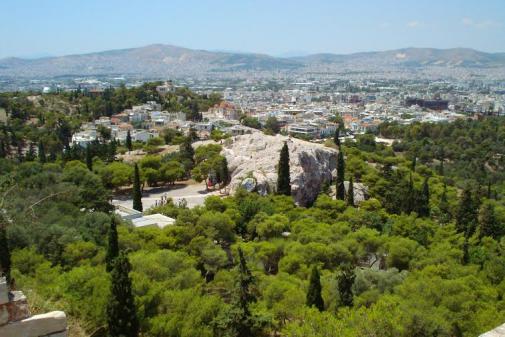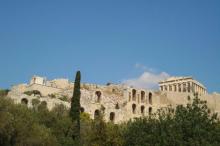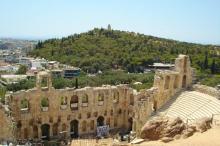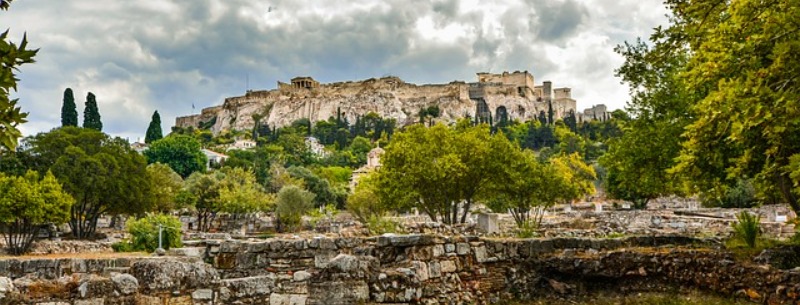It’s difficult to imagine finding peace and solitude in the heart of Athens, which is crammed with six million people and choked by exhaust-spewing traffic and cacophony. But soaring from the maze of streets and modern buildings are the hills and mountains of Attica, and a hike in the hills of Athens is worth the time and effort for a relaxing afternoon, a chance to get away from the city’s chaos.

Flowers blossom along the pathways, which are shaded by fragrant pine trees. Bees buzz around the yellow broom. You can’t really imagine there’s a city below in the silence, with only the echo of distant voices carried on a warm afternoon breeze. You’re the only one who can hear the birdsong. You are in ancient Athens, centuries away from the modern world.
The Acropolis
Athens lures foreign travelers like me with its unique history. Rising from the maze of narrow streets and modern buildings, the Acropolis is the most visited of the city’s eight prominent hills. The entrance, at Beule Gate, is an uphill walk from Dionysiou Areopagitou Street, a major road that skirts the south side of the Acropolis. The climb is worth the effort.
 This limestone plateau was used as a fortress by the Mycenaeans and later, in the time of Perikles (5th century BC) it was crowned with magnificent temples, including the ingeniously designed Parthenon, dedicated to Athena Parthenos, patron goddess of Athens. There is nothing more aw-inspiring than the sight of the Parthenon bathed in sunlight or flooded with golden light in the evening. It is truly Athens’ crown jewel. And after your visit, you must be sure to see the famous antiquities from the Acropolis now housed in the New Acropolis Museum.
This limestone plateau was used as a fortress by the Mycenaeans and later, in the time of Perikles (5th century BC) it was crowned with magnificent temples, including the ingeniously designed Parthenon, dedicated to Athena Parthenos, patron goddess of Athens. There is nothing more aw-inspiring than the sight of the Parthenon bathed in sunlight or flooded with golden light in the evening. It is truly Athens’ crown jewel. And after your visit, you must be sure to see the famous antiquities from the Acropolis now housed in the New Acropolis Museum.
Filopappos Hill
To the west of the Acropolis, with a view that sweeps from the Salamis Gulf to the Argolic Hills, is the Hill of the Muses, also known as Filopappos Hill. From here you are almost at eye-level with the Acropolis and you have a breathtaking view of the Parthenon. Below, the city stretches out for miles around, extending to the mountains of Parnas and Hymettus. At the crest of the hill you see a monument commemorating Filopappos, a prince of Syria who was exiled to Athens by the Romans and died there in AD 116. Not even such great heroes as Perikles were given this honor.
The Filopappos Hill or the Hill of the Muses is located opposite to the Acropolis. The hill took it name from the funeral monument built at its top in 115 A.D in memory of Gaius Julius Antiochus Philopappos who was a Roman consul. The monument was 10 metres high with statues of the family of Filopappos. The hill is pine-covered and the top offers incredible panoramic views over Athens, the acropolis and the Saronic Gulf. It is only accessible by foot. The hill also houses the small Byzantine chapel of Agios Dimitrios which contains some fine frescoes.
 Below, the hill has caves, cisterns and tombs. One of the caves is the alleged ‘prison’ where the philosopher Socrates was held before his execution.
Below, the hill has caves, cisterns and tombs. One of the caves is the alleged ‘prison’ where the philosopher Socrates was held before his execution.
You can access the trails and footpaths of Filopappos from Dionysiou Areopagtou Street. Opposite the tea pavilion and the rustic chapel of Agiou Dimitrou, flagstone footpaths lined with wild flowers wind up through the pine groves. Doves coo sleepily in the trees. Filopppos is a place to meditate and contemplate the marvels of this grand old city.
The Pnyx
The downward trail leads to the Pnyx, the meeting place of the ancient Assembly where such great orators as Demosthenes and Themistocles addressed the citizens of Athens. In the evening, you can come here to watch the spectacular Sound and Light Show, which tell s the history of the city.
The Pnyx Hill is located between the Philopappos hill and the Hill of the Nymphs. In the Ancient Times, in the 5th century B.C., it was the meeting place of the Democratic Assembly also called the “Assembly of the Demos”. All the famous orators of Ancient Athens such as Aristides, Demosthenes, Pericles and Themistocles delivered many speeches.
Beside the Pnyx is Mouseion Hill. Themistocles’ Long Wall ran south from here and commanded the road to the port of Pireaus. Opposite the Pnyx is the Hill of the Nymphs, the site of the Observatory.
The Areopagos
Walk back around the base of Filopappos and turn up past Areopagitou Street, along the path below the Acropolis. Here you will come to the stone-cut steps that lead up to the Areopagos. This Hill of Ares was the seat of the Supreme Court of ancient Athens. Kings of Mycenaean rule are buried in long tombs along its flank. This was the seat of the supreme court of ancient Athens.
 It was on this hill that Orestes, son of King Agamemnon of the Trojan Wars fame, was called to account for the murder of his mother, Klytemnestra. Nearby is the Cave of the Furies where Orestes took shelter. When the Apostle Paul came here in the year AD 50, he addressed the Athenians referring to Christ as “the unknown god” to whom one of the many altars on the hill was dedicated. Nearby is the little basilica dedicated to St.Dionysus the Areopagite, one of Paul’s first converts.
It was on this hill that Orestes, son of King Agamemnon of the Trojan Wars fame, was called to account for the murder of his mother, Klytemnestra. Nearby is the Cave of the Furies where Orestes took shelter. When the Apostle Paul came here in the year AD 50, he addressed the Athenians referring to Christ as “the unknown god” to whom one of the many altars on the hill was dedicated. Nearby is the little basilica dedicated to St.Dionysus the Areopagite, one of Paul’s first converts.
The Areopagus hill is situated just bellow the entrance of the Acropolis, between the Acropolis and the Ancient Agora. According to mythology, it was here that the god of war, Aris, was tried by the council of gods for the murder of the son of Poseidon, Halirrhothios.
The hill was, in Ancient Times, the place where murder trials took place. Areopagus Hill is also the place where Apostole Paul came to proclaim the Christianity with his famous “sermon on an Unknown God”in 51 A.D. Among his converts, he won Dionysos who became the Patron Saint of the city.
The Areopagus Hill is easily accessible by steps sculpted into the rock. The hill offers a great panoramic view over the acropolis, the Ancient Agora and the west part of Athens. In summer time nights, this place attracts many people and offers a peaceful atmosphere.
Lykavittos Hill
On the other side of town, the Lykavittos Hill can be reached by foot, car or funicular railway. It’s Athens’ highest point (270 meters), a pine-covered hill that is visible from almost every part of the city. Once wolves roamed freely here and the hill’s name means “Hill of the Wolves” The 19th century chapel of St. George crowns the top of the hill. There’s a café and restaurant on the top where you can enjoy the incredible views of Athens. On clear days you can see as far away as the islands of Aegina and Salamina. The Lykavittos Theatre is famous for its festivals and concerts where national and international artists perform.
The hill of Lykavittos is the highest point in Athens rising 270 meters above the megalopolis. It is a pine covered hill visible from every part of the city. The name of the hill means “hill of the wolves” and the legend says that this name derives from the ancient times when the wolves roamed freely on the hill, then surrounded by countryside.
Lykavittos hill is the highest point of Athens and offers an incredible panoramic view over the entire city and the surroundings mountains. Depending on the level of pollution, the hill permits, some days, views to the port of Piraeus and even the islands of Salamina and Aegina.
At the top of the hill is the 19th century picturesque chapel of St.George built on the location of the Byzantine church of Prophet Ilias.
The Lykavitos hill is also famous for its theatre which welcomes many artists from the national and international scene for jazz and rock concerts, spectacles and many festivals.
The top of the hill can be reached by foot, by car or a funicular rail-way from the neighbor of Kolonaki. The visitor can also find at the top of the hill a café and one of the most luxurious restaurants of Athens with both incredible views over the city.
The west of Acropolis
This area is characterised by the Areopagus hill, the Filopappos Hill and the Hill of the Pnyx and the Hill of the Nymphs.
Below the hills of Athens, the city throbs with life, but you have been in touch with the past. You have seen Athens in the beauty that was of the ancient times.
PARKS OF ATHENS
The National Gardens
The National Gardens (Etnikos Kipos) or Kings Gardens are situated behind the Greek Parliament and the central square of Syntagma. These gardens were originally the royal gardens and were designed by Queen Amalia in the 19th century. These gardens are, during the hot summer, an oasis of cool.
The gardens contain some interesting kind of trees and plants, duck ponds, a small zoo and a botanical museum which houses drawings, paintings and photographs. Many efforts have been done to clean up the gardens and to offer to the animals captured in the zoo more comfortable conditions.
The gardens also houses a playground and some nice cafés.
The Zappeion Gardens
The Zappeion Gardens are located next to the National Gardens and just off the central Square of Syntagma. In the center of the gardens is located the Zappeion Megaron, a beautiful neoclassical building erected in 1874-1888. It was originally built in order to host the first modern Olympic Games which took place in Athens in 1896.
The building was since then used as a center for international conferences and was many times witness of many of Greece’s important political moments.
The Areos Park
The Areos Park is located on Leoforos Alexandras (Av.), not far from the National Archaelogical Museum. It is a large and calm park.
